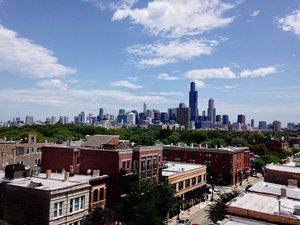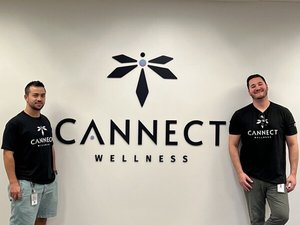In fall of 2015, Skokie-based materials science company Polyera burst onto the wearables scene with its flexible display Wove Band.
There were few places you could look in the tech world without seeing a demo of the product (including Wired, TechCrunch, PC Mag, CNBC, The Verge and even right here on Chicago Inno), a wearable with an e-ink display that wrapped around the wrist. The idea was to create a truly flexible display that could twist, bend and fold, and a wearable that didn't have the battery life or screen space constraints of the others on the market. The device was also meant to show off the potential for Polyera's flexible screen technology, which the company believed could be used in other applications (think tablets that roll up like newspapers).
That fall, Polyera said they expected to get the product to market by 2016.
What took place instead were layoffs, a pivot and an uncertain future for a hyped consumer product that raised $35 million in funding.
Polyera and Italian materials company SAES Group have created a new company called Flexterra. Both companies contributed equipment, intellectual property assets and staff to the new venture, and future operations of Flexterra will be financed by a new investment from SAES and Polyera’s investors. This new company will not develop consumer electronics products in-house, but rather develop flexible display materials and work with display manufacturing partners to bring this tech to the market. SAES will serve as a materials manufacturing partner to Flexterra, and Polyera will be a technology brand within the company.
While Flexterra is still based in Skokie and the company maintains a lab in Taiwan, their largely product-focused San Francisco office is no more, and California employees were let go between January and July of 2016. The company is down to 30 employees, from a high of around 100 employees in 2015. After structuring the deal with SAES in July, former CEO Phil Inagaki has moved on to a new company (Cambridge, Mass. 3D printing startup Voxel8) and Doni Fabrizio, formerly COO at SAES, has been named CEO of the company. Most notably, they will not be producing the Wove Band like originally planned; Flexterra is in discussions with an outside end product company to take the Wove Band, or a similar product, forward.
"The overall mission and business model of Flexterra returned to the 'origin' of Polyera, which started solely as materials company," said Antonio Facchetti, chief scientific officer of Flexterra to Chicago Inno over email. "We [refocused] R&D to enable the first products to be realized as soon as possible rather than carry multiple R&D lines at the same time."
Those familiar with the past year and a half of Polyera's business say the focus on product didn't go as anticipated, and the startup ran into issues fundraising. Now they're hoping their portfolio of intellectual property and R&D efforts will create a path for their flexible electronics technology moving forward.

Polyera started back in 2005 as a materials company based off the work of Northwestern University chemists Tobin Marks and Antonio Facchetti. For 10 years the team quietly worked out of a lab in Skokie developing proprietary technology (even to the extent of inventing new molecules) that eventually would have a commercial application--in this case, a wearable device that could twist, bend and flex. Previously, the startup raised $35 million in equity funding, including a $24.5 million Series C from Chinese firms Chengwei Capital and Tsing Capital in 2012.
Finally in 2015, after opening a manufacturing lab in Taiwan, a product office in San Francisco and maintaining the research and development office in Skokie, Polyera debuted the Wove Band. In a conversation with Chicago Inno in October 2015, Inagaki doubled down on the technical viability of Polyera's product, saying "the Wove Band is meant to be a meaningful product, it is not an experiment." At the time, the company projected the Wove Band would be available to the public by mid-2016.
Behind the scenes, however, things weren't going according to schedule, according to those who were with the company at the time. The company raised bridge funding through 2015, largely from existing investors, with the goal of raising a $25 million Series D round, which would help the company bring the product to fruition.
But discussions with new investors fell through. Those familiar with investment talks said VCs mentioned they wanted to see some additional market acceptance (such as a Kickstarter campaign) and more manufacturing progress, or passed because didn't have the domain expertise (the fact that Polyera was positioned both as a B2C and B2B company also made it a more difficult pitch). In addition, launching a hardware product and paying for talent to develop it can get expensive, especially with an office in the Bay Area and the need for funding--or a change in direction--grew increasingly apparent.
In December 2015, final talks with investors ended. There was a board meeting to decide next steps for the company, and the board voted to forgo product and instead refocus on their research and development roots. By early January 2016, Polyera decided to close the California office and 35 employees that worked on Polyera's consumer electronics product development were laid off over the next six months.
The company also spent those six months searching for the right partner moving forward. They were in talks with several European and Chinese companies involved in the display supply chain, but as summer rolled around and funds were dwindling, Polyera decided to enter into an agreement with the SAES Group to form Flexterra. Polyera's previous investors, including Tsing Capital and Chengwei Capital, will contribute a total of up to $7 million of additional funding to Flexterra, while SAES is contributing $13 million in cash into the deal. The final closing of the deal is set for later in 2017.
Polyera had an on-going collaboration in the area of organic light-emitting transistors dating back to 2010 with SAES. The 77-year-old Italian company, which has been a pioneer in getter technology, has as long history in the advanced materials and display industries. In more recent years, SAES has expanded their product offerings to include getter and encapsulation technology for OLED displays. They also have the customer relationships and production capabilities that can help Polyera scale tech faster.
"We knew they had been successful bringing new technologies based on new materials to market, numerous times, so it was an obvious fit," said Brendan Florez, the former president of Polyera who is currently helping the company through its transition to Flexterra.
The smartwatch and wearables market hasn't taken off as predicted, even beyond Polyera. Smartwatch device shipments declined by 51.6 percent year-over-year as of the end of 2016. Fitbit laid off 110 workers in January after slow holiday sales. Jawbone is reportedly moving away from consumer products to focus on the healthcare market.
Moving forward, Flexterra will be focused on the Polyera materials technology, but not the consumer electronics product technology. They will be focused on developing Polyera's flexible transistor materials technology and bringing flexible display products to market through display manufacturing partners. Flexterra's R&D roadmap includes moving beyond e-ink displays and expanding to color and OLED displays, as well as printed electronics applications such as sensors. Flexterra is also exploring licensing opportunities for Polyera’s consumer electronics products technology.
Chief scientific officer Facchetti added that he's looking forward to working with electronic materials that enable organic thin film transistor (OTFT) technologies, which feature bright, vivid color on thin paper-like displays.
"The opportunity is to focus resources and to ensure our consumer electronics customers that we do not intend to 'compete' within the same product space," he added. "This should push the introduction of our materials."
Note: The story has been updated to clarify the Flexterra's investors.








